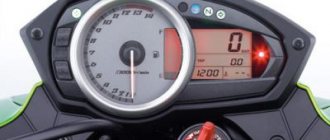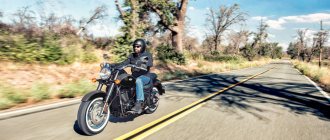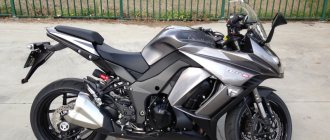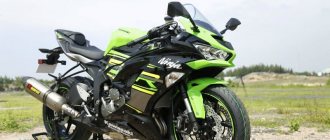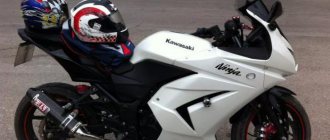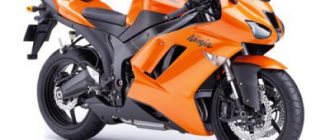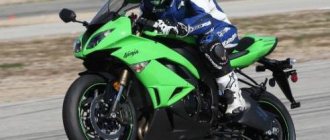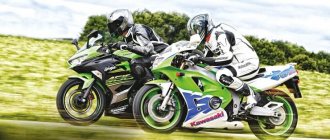Character traits
The motorcycle had the following undeniably positive features:
- he quickly accelerated and developed a high speed for those times;
- the bike had an excellent design, reminiscent of the hits of recent years;
- in addition, the motorcycle was balanced in its characteristics.
With all this, the bike was quite small in size, which made it a classic for its sports class. It will be remembered for a long time by those who saw the time when sports motorcycles were just beginning to gain momentum in their development.
The motorcycle has a long history, during which serious changes in its design and career have occurred more than once, new versions have appeared, and errors have been corrected. And here’s what’s remarkable: despite the fact that production of the model began back in 1995, it is still in production. More than twenty years on the market and well known, isn’t this an absolute indicator of success?!
Specifications
In terms of its technical parameters, the motorcycle was ahead of its era. While other bikes were just beginning to look like modern representatives of the sports class, this beauty was already demonstrating with all its might the capabilities that would soon open up for others.
The Kawasaki 3X6R has a powerful engine, a reliable transmission, and high-quality brakes... But it is also a whole series of changes that occurred from one year to another, from version to version, and made the motorcycle better and better!
Engine
The motorcycle is equipped with a four-stroke engine. It has 4 cylinders. The type of engine is in-line. It is liquid cooled. The compression ratio of more modern versions is 12.9:1. As for the working volume, it is 636 cubic centimeters.
New versions of the motorcycle can reach a speed of 100 kilometers per hour in 3 seconds, and not in 3.5, as before. The maximum speed of this model is 267 kilometers per hour, and it has been like that from the very beginning, and this was 1995! Of course, it also has to do with the motorcycle engine.
The maximum torque is now 71 Newton meters at 11,500 rpm. It is worth noting that at first it was only 64 Newton meters at 10,000 rpm, but even now this does not look like a small figure!
Power at its peak is now 131 horsepower at 13,500 rpm. At first, the maximum power was 105 horsepower at 12,500 rpm, which is also a very good indicator.
Transmission
The gearbox of this motorcycle consists of six stages. The drive is of a chain type. This is quite enough for the bike to easily reveal the potential of its engine and be successfully controlled at different speeds. Perhaps the transmission will be changed someday, but even if not, it will not be critical.
TEST RIDE: KAWASAKI NINJA ZX-6R 2009 ON THE KYALAMI TRACKThe new ZX-6R is available for $9,799 in green or orange and Monster racing graphics (this option costs a little more).
04/05/2009 To the uninitiated, the 600 cc engine may seem very weak, but when I sit on the saddle of 600-class sportbikes, I always remember that these little machines are extremely high-performance.
When I first accelerated the new Kawasaki Ninja ZX-6R motorcycle to the red zone of 16,500 rpm, I was convinced that the machine was not “weak”, but quite the opposite. (https://www.kawasaki.com/Products/product-specifications.aspx?id=374&scid=24Follow the link to watch Kawasaki's official video about the new Ninja ZX-6R motorcycle).
The bike Dane Hellyer rode to win the 2008 South African Supersport 600cc Championship. see, in 2009 it was modified in many aspects. The next day I came to the Kyalami track to check how much better the new car was.
Yes, the bike has become more powerful, but it has also lost 10 kilograms of weight, which has improved its agility. At the front there is a new Showa BPF (Big Piston) fork, which is installed on a mass-produced motorcycle for the first time. The fork has improved damping control and significantly reduced unsprung weight.
If you want to complete faster track laps, you can change the bike's settings to suit the track and your riding style: preload, compression and rebound force.
The frame was modified - rigidity was improved and the center of gravity was raised so that the motorcycle could corner faster and the handling would be sharper. Stylistic and ergonomic changes are expressed in the new shape of the gas tank and saddle - the driver’s position becomes more compact, allowing him to merge with the car and control it better.
The engine's power, which has become lighter and more powerful, rises from 92.2 to 94.1 kW without turbocharging (when additional air begins to flow, power increases from 96.6 to 98.5 kW). At medium speeds the torque value has increased.
Increased mid-range torque is the first thing I noticed while doing laps of the Kyalami track. And the bike “spears into battle” already from 8000 rpm. I know that for the uninitiated, this phrase may seem stupid, but most six hundred at these speeds are just beginning to “clear their throats”, and the ZX-6R still has 8500 rpm left. to the red zone!
And when the bike begins to foam up, this Ninja races forward like a cheetah with its tail on fire, the front wheel trying to throw its paws into the air, even though you're leaning on the gas tank and putting all your weight forward.
When it comes to handling, this bike is perfect for the race track, just like Pamela Anderson is suited to a swimsuit. The new ZX-6R loves to turn fast, and the faster I went into the corners and the sooner I opened the throttle, the more the bike seemed to ask me, “Is this all you can do?”
My knee sliders were very worn out, but the bike calmly passed laps of the track, without trembling, and without straying even a hair's breadth from the chosen trajectory. The new Ohlins steering shock absorber (damper) holds the steering wheel stable, and you don't feel the scary fork vibration.
The brakes are amazingly powerful, and the slipper clutch prevented the rear wheel from bouncing when I downshifted while braking. An amazing feature for a bike designed for the track.
Returning home from the track is a different story. Regular riding quickly develops a feeling of fatigue, as the suspension is stiff and the radical saddle position places all the weight on the wrists. The ZX-6 isn't meant to be a daily commuter; after several kilometers in the general traffic flow, your arms and back begin to go numb, ache and beg for mercy.
The new ZX-6R is available for $9,799 in green or orange and Monster racing graphics (this option costs a little more). And don't forget that you'll need to factor in the money you'll pay for the tracks, since race tracks are where you'll want to spend most of your time.
Author: Denis Droppa Translation (authorized): MotorLand.ru, IMC Holding
SPECIFICATIONS Kawasaki Ninja ZX-6R 2009 model year
Engine: four-stroke, inline-four, four valves per cylinder, liquid cooled, DOHC (dual overhead camshafts) Displacement: 599 cc cm Bore and stroke: 67.0 x 42.5 mm Maximum torque: 66.7 Nm (6.8 kgf/m) at 11800 rpm. Compression ratio: 13.3:1 Fuel injection system: DFI® with four 38 mm Keihin gates, two injectors per gate Ignition: TCBI digital advance Transmission: six-speed Final drive (final drive): X-Ring chain Rack Column Tire / Trail (Trail): 24 degrees / 4.0 in. (10.16 cm) Frame Type: Aluminum Perimeter Front Tire: 120/70-ZR17 Rear Tire: 180/55-ZR17 Wheelbase: 55.1 in. (140 cm) Front Suspension/Wheel Travel: Showa Big Piston 41mm inverted fork, continuously variable compression and rebound adjustment, fully adjustable spring preload/4.7 in (12 cm) Rear Suspension/Wheel Travel: Bottom Suspension -Link Uni-Trak® with gas shock absorber, two range (high and low speed) continuously variable compression force adjustment, 25 position rebound force adjustment, fully adjustable spring preload / 5.3 in (13.5 cm) Front brake: dual petal 300 mm diameter disc with radial four-piston opposed calipers Rear brake: single 220 mm diameter petal disc with single-piston floating caliper Fuel tank capacity: 4.5 gallons (17 liters) Seat height: 32.1 inches (81.6 cm) Curb weight: 421.1 lbs 192 kg) Colors: Lime Green, Metallic Diablo Black / Flat Super Black, Candy Surf Blue / Flat Super Black Warranty: 12 months.
Kawasaki Ninja ZX-6R 2009 model year:
Source: https://www.motorland.ru/1mc2009/kawasaki_zx6r_test.html
Read the continuation of the material here:
Kawasaki Ninja ZX-6R
Chassis and brakes
Unlike many other Kawasaki models, the Ninja ZX6R has an aluminum frame. However, this is not a minus of it, but simply a feature. The body has an aerodynamic shape, which is almost no different from those made for bikes in recent years.
The rear suspension of the motorcycle is pendulum and equipped with a monoshock absorber. The front suspension is provided by a 41mm inverted fork. The rear brakes on the motorcycle are 220mm in diameter and paired with a single-piston caliper. The front brakes feature dual 310mm discs with four-piston radial calipers.
The steering wheel of the model is comfortable, making it easy to maneuver at speed. Alloy wheels are a very sporty option that looks impressive even in comparison with the steel monsters of recent years. Both the chassis and brakes do their job perfectly and make the motorcycle relevant to this day.
Technical characteristics of the Kawasaki Ninja ZX-6R motorcycle (2007)
| Engine | ||
| Type | liquid-cooled, four-stroke inline four-cylinder | |
| Volume, cm3 | 599 | |
| Piston diameter/stroke, mm | 67 x 42.5 | |
| Compression ratio | 13,9:1 | |
| Gas distribution system | DOHC, 16 valves | |
| Fuel system | Fuel injection: ∅ 38 mm x 4 (Keihin) additional oval throttle bodies, dual injection | |
| Ignition | electronic | |
| Starter | electric | |
| Lubrication system | pressure lubrication, wet sump | |
| Engine characteristics | ||
| Power, hp | 125 at 14000 rpm. | |
| Power with inertial supercharging, hp | 131 at 14000 rpm. | |
| Torque, Nm | 66 at 11700 rpm. | |
| Chassis | ||
| Transmission | 6 gears | |
| Drive unit | chain in casing | |
| Main gear ratio | 1,900 (76/40) | |
| Gear ratios | 1st gear | 2,714 (38/14) |
| 2nd gear | 2,200 (33/15) | |
| 3rd gear | 1,850 (37/20) | |
| 4th gear | 1,600 (32/20) | |
| 5th gear | 1,421 (27/19) | |
| 6th gear | 1,300 (26/20) | |
| Total gear ratio | 2,688 (43/16) | |
| Clutch | multi-disc, oil bath, manually operated | |
| Frame | ||
| Frame | Perimeter stamped aluminum alloy frame | |
| Suspension travel, mm | front wheel | 120 |
| rear wheel | 133 | |
| Tires | front wheel | 120/65ZR17M/C |
| rear wheel | 180/55ZR17M/C | |
| Fork axis tilt angle, degrees. | 25° | |
| Fork axis tilt angle, mm | 110 | |
| Suspension | ||
| Front suspension, type | inverted fork with top springs, stay diameter 41 mm | |
| Rear suspension, type | Uni-Trak with lower control arm, gas-charged shock, overhead springs, spherical bearing top mount | |
| Compression shock absorber | stepless | |
| Rebound shock absorber | stepless | |
| Brakes | ||
| Front | Type | two semi-balanced disks with a diameter of 300 mm (thickness 6 mm) |
| Caliper | two radial mount calipers, 4 aluminum opposed pistons, 4 pads (Nissin) | |
| Rear | Type | one semi-floating petal disc, diameter 210 mm (thickness 5 mm) |
| Caliper | single cylinder, guide pin, aluminum piston (Tokico) | |
| dimensions | ||
| Total length, mm | 2105 | |
| Full width, mm | 720 | |
| Total height, mm | 1125 | |
| Wheelbase, mm | 1405 | |
| Ground clearance | please clarify further | |
| Seat height, mm | 820 | |
| Dry weight, kg | 167 | |
| Fuel tank capacity, l | 17 | |
Trade code: ZX600P
History of changes
The motorcycle went through a number of changes during its development:
- 1995 – the model was released;
- 1998 – small update;
- 2000 – the compression ratio increases;
- 2002 – engine capacity increases;
- 2006 – suspension update;
- 2010 – large-scale changes.
This bike is one of the most “long-lasting” among motorcycles from the legendary concern. At least for this reason it deserves attention. In the end, the manufacturer worked for a long time to remove errors and shortcomings, and in the end he succeeded.
Kawasaki
In 2010, the Kawasaki Ninja ZX-6R was launched with nice modifications to the chassis and engine.
The first has become lighter and more adaptable to cornering, while the second has become more powerful and has better torque. Additionally, the bike is designed like its big brother without much visual difference between the two. The Kawasaki Ninja ZX-6R has a ton of new features, starting with the Showa large piston fork. The large piston is very effective under heavy braking, which is very important for corner entry braking, reducing damping pressure and improving fork feedback. The second important factor is the lighter weight of the fork when using a large piston, as it simplifies the design.
It is also interesting to look at the updated engine of the ZX-6R motorcycle. Engineers achieved more mid-range torque by adding re-profiled cams and pistons, as well as new rings. The cam chains may have been replaced. In addition, the manifold now has a new location and also seems to have something to do with the increase in low- and mid-range torque.
Since weight is a key factor, it has been reduced by redesigning the injector mounting plane, narrowing the gearboxes, and redesigning and relocating the reservoir. As for the chassis, we also had to work on reducing weight and improving the rigidity of the frame around the pivot point of the pendulum. Like all modern sportbikes, the Kawasaki ZX-6R is equipped with a short, single-sided muffler.
After all the modifications and changes to the chassis, the seat height has become 10 mm lower. The stabilization of the sport landing was adjusted by moving the steering wheel closer to the pilot. Additionally, the fuel tank has been slightly redesigned to give the pilot more room to merge with the fairing. The updates also affected the braking system. Up front there is now a pair of 220mm disc brakes (10mm larger than previous models).
Technical characteristics of Kawasaki Ninja ZX-6R 2010:
• Engine: Four-stroke, liquid cooled, DOHC, four valves per cylinder, in-line four-cylinder • Displacement: 599 cc • Bore x stroke: 67.0 x 42.5 mm • Compression ratio: 13.3:1 • Fuel injection system: DFI with four 38 mm Keihin throttle bodies • Ignition: TCBI • Transmission: 6 speed • Final drive: chain • Rake/trail: 24 degrees/104 mm • Frame type: Aluminum • Front tire: 120/70 ZR17 • Rear tire: 180/55 ZR17 • Wheeled wheelbase: 1400mm • Front suspension/travel: 41mm Showa Big Piston Front inverted fork/120mm • Rear suspension/travel: gas shock, adjustable, 25 positions/135mm • Front brake: 300mm discs, pair, calipers four-piston • Rear brake: 220 mm disc with single-piston caliper • Overall length: 2090 mm • Overall width: 711 mm • Overall height: 1115 mm • Fuel tank: 17 l • Seat height: 815 mm • Weight: 191 kg
- Torque: 69 Nm at 11,800 rpm
- Power: 124.3 hp at 13,500 rpm
- Limit speed: 250 km/h
- MSRP: $10,500
